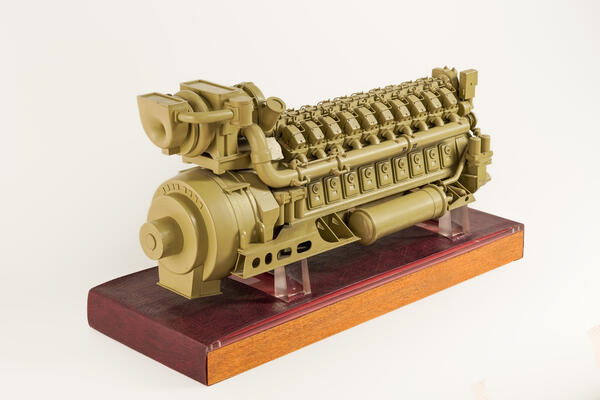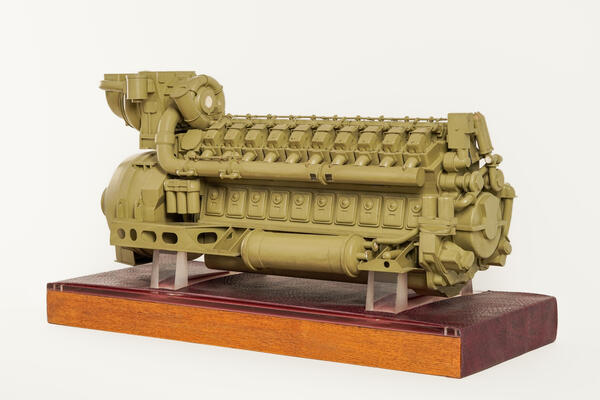The Kolomna Machine-Building Plant was one of the first in the world to launch production of a new class of heat engines — the diesel ones. In 1903 the first unit was produced. When the world’s first motor ship, the “Kolomna Diesel”, was built in 1907, the plant became the leading Russian enterprise in building motor ships as well.
The dawn of the multi-purpose diesel engine standard series D49 should be attributed to the first half of the 1960s, when the Kolomna Machine-Building Plant was assigned the task to create a multi-purpose series of engines with the power range up to 12,000 hp. The work was carried out in fierce competition. Two groups of talented engineers in the Kolomna Plant design bureau were competing. The group of the leading designer B. N. Nazarenko proposed to create a series on the basis of an L-shaped two-stroke diesel engine with oppositely moving pistons and three crankshafts with the dimension of 2×23/30. The group of the leading designer A. I. Meden proposed a design of a four-stroke diesel engine in the form of a star-shaped seven-beam star in a single row with the dimension of 26/26. Although at the beginning of developing the engines of the D49 dimension the plant produced excellent two-stroke engines of DN23/30, preference was given to four-stroke perspective series of the ChN26/26 dimension. The first prototype of a diesel locomotive version was built in 1965. The history that followed showed that it was the right choice. 1965 should be marked as the date when the D49 diesel engine era began.
The D49 configuration was a new step in the domestic diesel engine building. It represented a design of a new generation, created entirely by talented specialists of the Kolomna design school, established by that time. A qualitative breakthrough in the development of D49 was made in 1982 with the adoption of a flat crankshaft suspension joint and transition to a steel nitrided crankshaft.
The fourth generation of diesel engines was produced at the Kolomna plant in 2001–2017. Over the entire period of producing D49 diesel engines of different generations. more than one hundred modifications for different purposes have been produced, which in itself is unprecedented for products created in Russia.
The dawn of the multi-purpose diesel engine standard series D49 should be attributed to the first half of the 1960s, when the Kolomna Machine-Building Plant was assigned the task to create a multi-purpose series of engines with the power range up to 12,000 hp. The work was carried out in fierce competition. Two groups of talented engineers in the Kolomna Plant design bureau were competing. The group of the leading designer B. N. Nazarenko proposed to create a series on the basis of an L-shaped two-stroke diesel engine with oppositely moving pistons and three crankshafts with the dimension of 2×23/30. The group of the leading designer A. I. Meden proposed a design of a four-stroke diesel engine in the form of a star-shaped seven-beam star in a single row with the dimension of 26/26. Although at the beginning of developing the engines of the D49 dimension the plant produced excellent two-stroke engines of DN23/30, preference was given to four-stroke perspective series of the ChN26/26 dimension. The first prototype of a diesel locomotive version was built in 1965. The history that followed showed that it was the right choice. 1965 should be marked as the date when the D49 diesel engine era began.
The D49 configuration was a new step in the domestic diesel engine building. It represented a design of a new generation, created entirely by talented specialists of the Kolomna design school, established by that time. A qualitative breakthrough in the development of D49 was made in 1982 with the adoption of a flat crankshaft suspension joint and transition to a steel nitrided crankshaft.
The fourth generation of diesel engines was produced at the Kolomna plant in 2001–2017. Over the entire period of producing D49 diesel engines of different generations. more than one hundred modifications for different purposes have been produced, which in itself is unprecedented for products created in Russia.






